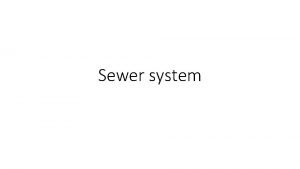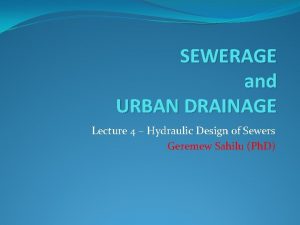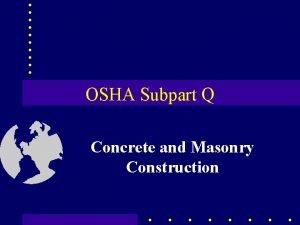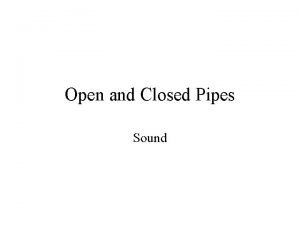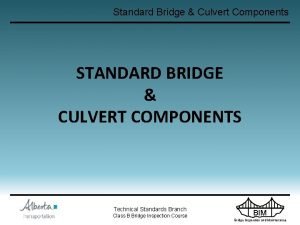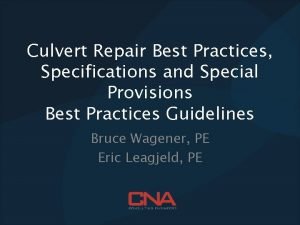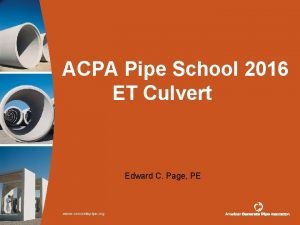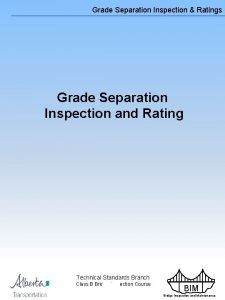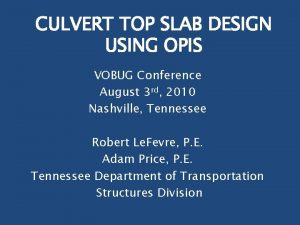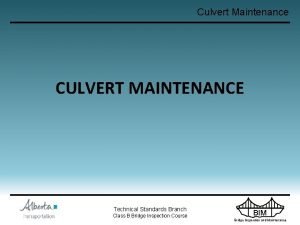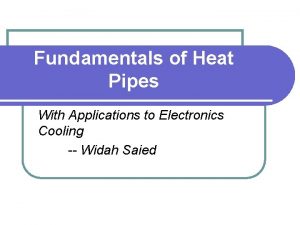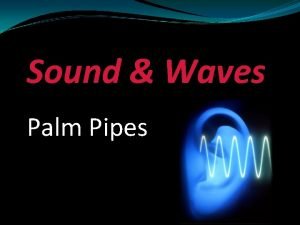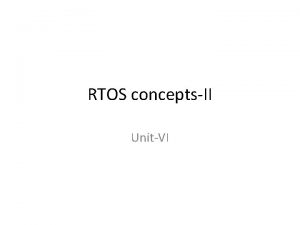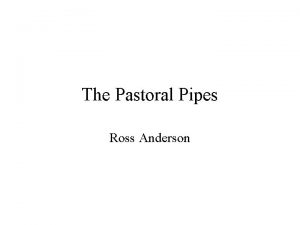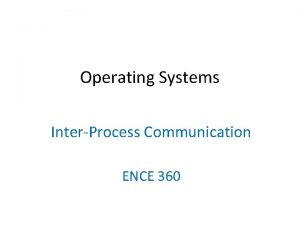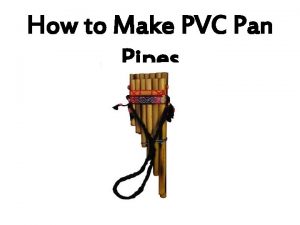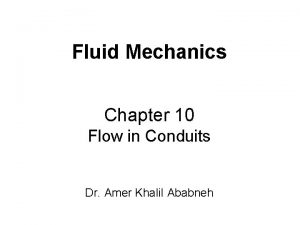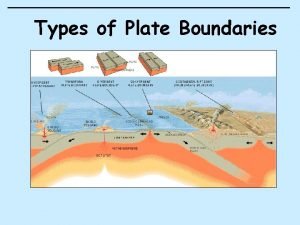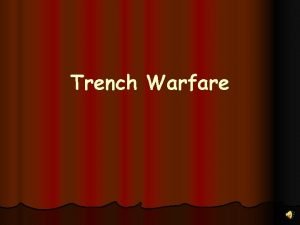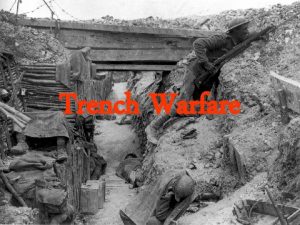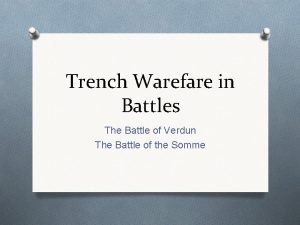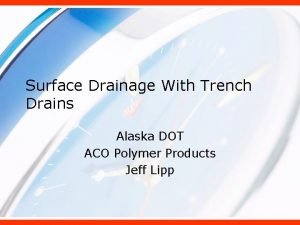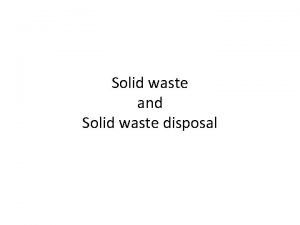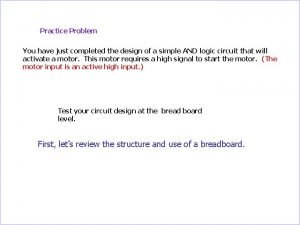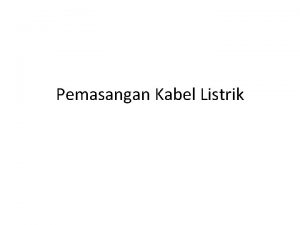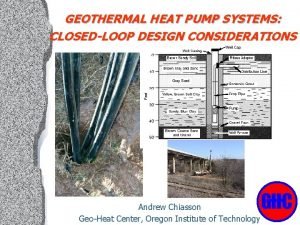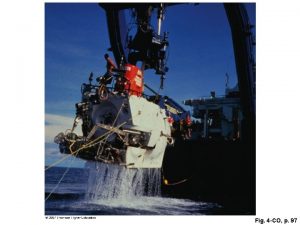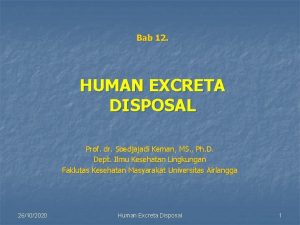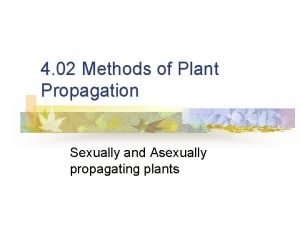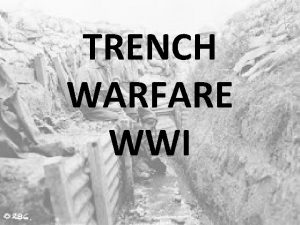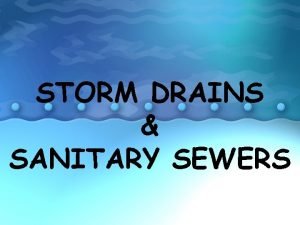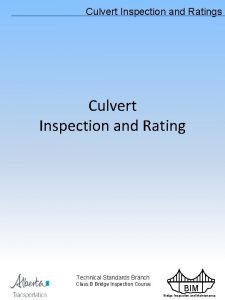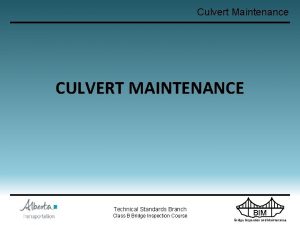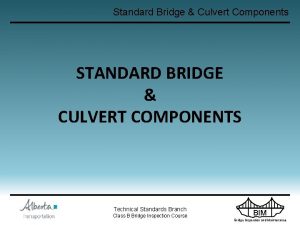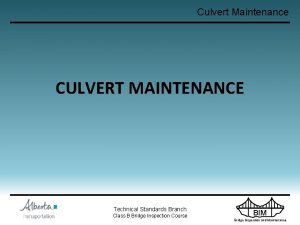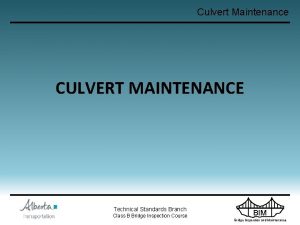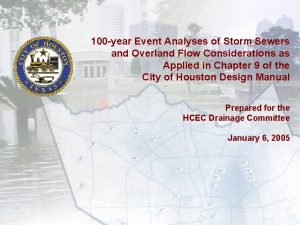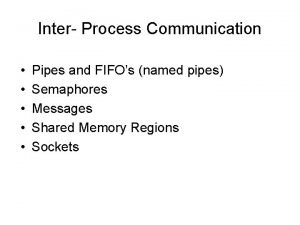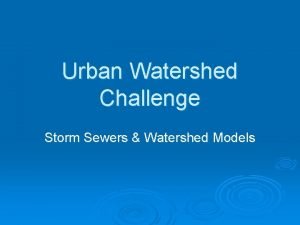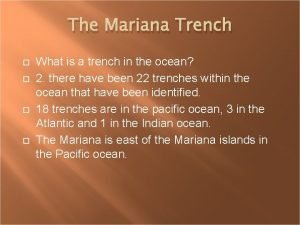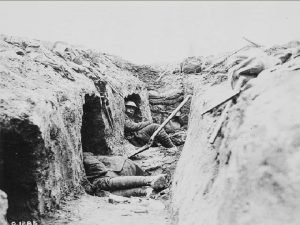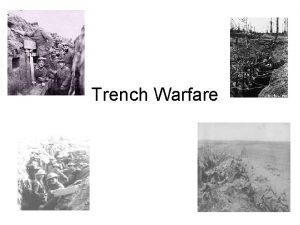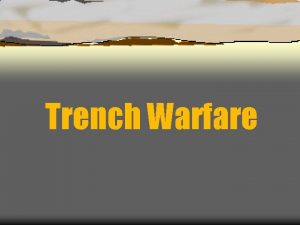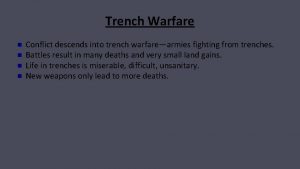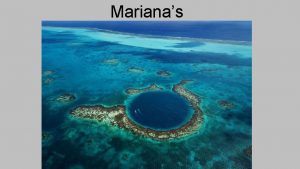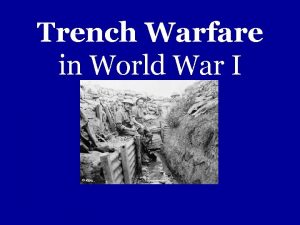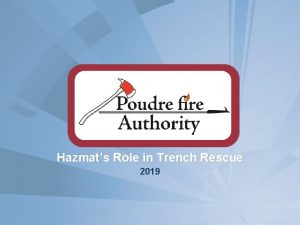Culvert Pipes and Storm Sewers 1 The Trench















































- Slides: 47

Culvert Pipes and Storm Sewers 1. The Trench 2. Pipe “Template" 3. Placing Pipe In a Trench 4. Bedding the Pipe 4. Pipe Joints 5. Foundation Backfill Material and Compaction 6. Pipe Cover and Avoiding Damage

Culvert Pipes and Storm Sewers Pipe Materials - What to Look For Concrete Cracks, Out of Round, Chips, Exposed Reinforcement, Required Markings Metal (Galvanized Steel or Aluminum) Dents, Rust, Out of Round, Coating Damage, Scratches, Required Markings PVC & Composites Required Markings, Strength such as Schedule 40

Types & Strength of Pipes 1. Type III, IV, etc. Pipe Strength Numbers Usually Scratched on Pipe. Example Type III has One Row of Steel Mesh Type IV has Two Rows of Mesh. Type IV Used Under Railroads or Where Cover May Be an Issue. 2. Elliptical or Squash Pipes Gives More Cover But Not as Strong. Manufacture Pipe Specifications May Require More Cover Than an Equal Capacity Round Pipe. 3. Composites Becoming More Common. Check Manufactures Specifications to Determine if Pipe Meets DOT Specifications. Also Some Local Governments May Not Allow Substitutions.

Culvert Pipes and Storm Sewers Table 520 -1: Allowable Materials for Culvert Pipe Class III Allowable Materials - Culverts -Class III reinforced concrete, corrugated steel pipe of the thickness the contract designates III-A -Class II and Class III reinforced concrete, corrugated steel of the thickness the contract designates, corrugated polyethylene, corrugated polypropylene III-A Non -Class II and Class III reinforced concrete, corrugated Metal polyethylene, corrugated polypropylene III-B -Class III reinforced concrete, corrugated steel of thickness the contract designates, corrugated polypropylene III-B Non -Class III reinforced concrete, corrugated polypropylene Metal IV -Class IV concrete pipe, corrugated steel pipe of the thickness the contract designates V -Class V concrete pipe, corrugated steel pipe of the thickness the contract designates

Culvert Pipes and Storm Sewers Table 608 -1: Allowable Materials for Storm Sewer Class Allowable Materials – Storm Sewer II III-A -Class II reinforced concrete -Class II and Class III reinforced concrete, corrugated polyethylene, corrugated polypropylene -Class III reinforced concrete, corrugated polypropylene -Class IV concrete pipe -Class V concrete pipe III-B IV V • Note: No corrugated steel pipe. Usually in urban situations where local government will own and maintain road. Is there a local preference?

Culvert Pipes and Storm Sewers Section 611: Catch Basins, Manholes and Inlets • Materials allowed are the same as those for storm sewers • Bedding and backfill requirements are the same as those for the respective pipe application • Can be cast-in-place, precast or site-built of approved block or brick • Do not allow height adjustment of covers with wood shims or any other non-approved methods • Height adjustments must be made with concrete, approved brick or block or DOT approved risers

The Trench 1. What to Look For 2. Correct Grade Line 3. How Wide? 4. Placing Pipe in a Trench

What to Look For 1. Generally, No Soil Borings or Information Soil Borings May Have Been Taken for Some Larger Pipes. 2. Foundation Inspection Basically the Same as Embankment Compaction. Can Use a Rod or Bar Steel to Probe the Trench Bottom. 3. Something Doesn’t Look Right Muck, Buried Topsoil, Logs, etc. If Base is Unstable, May Need to Over Excavate and Place Suitable Material (Extra Pay). 4. Contractor is Responsible for Following OSHA Excavation Requirements -

The Trench Grade Line 1. Does it Flow? Is the Flow Line Straight? Don’t pond water in the pipe. 2. Camber Some culvert pipes placed under embankments may require a cambered grade. The portion of the pipe under the roadbed supports a greater load than the ends. To compensate for additional settlement, a camber or slight convex curve, is sometimes specified by the engineer and built into the grade line of the culvert. Camber is used when soil beneath the pipe is expected to consolidate or settle. (Generally under new earth fills. )

The Trench Width 1. Is There a Specification? Standard Specification 520. 3. 2. 1 (3) "Make trenches wide enough to provide free working space on each side of the pipe. This space shall not exceed ½ the nominal diameter of the pipe, and never less than 6 inches. ” Culvert pipes also have other trench width requirements identified in this section, based on type of pipe material. 2. Wide Enough to Compact Backfill with Equipment Generally 18 inches between the pipe and trench side is enough. 3. Any Restrictions? Utility in the way. Other structure conflicts such as footings, walls or piling.

The Trench Width Shallow to Medium Depth Culvert & Sewer Pipe Trench

The Trench Width Medium to Deep Depth Culvert & Sewer Pipe Trench

Pipe Trenches in Bed Rock 1. How Wide? Usually 1. 5 times the Outside Diameter of the Pipe. But Need to Provide Adequate Room for Compaction Equipment. 2. How Deep? Minimum 6” Deeper Than the Bottom of the Pipe. Don’t Pay for Rock Excavation Greater Than the Standard Trench Width and Depth Just Because the Contractor Over Excavated.

Culvert Pipe Template Earth Bed Shaped or Trimmed to Give Full Support for at Least 1/10 Outside Diameter of Circular Pipes. Labor Intensive. Not Used Much Anymore.

Placing In a Trench 1. Don’t Build Grade Around Pipe. 2. Contractor is Required to Build Grade to 1 Foot Above Top of Pipe. 3. Then Trench is Cut, and Pipe is Placed.

Placing in a Trench

Placing in a Trench

Foundation Backfill – Culverts Foundation Backfill (Bedding) Specification 520. 2. 5. 2. 2: Gradation (1) Furnish Foundation Backfill with a gradation conforming to the following: - For the entire sample conform to the following gradation limits: SIEVE 1 ¼ inch No. 4 PERCENT PASSING BY WEIGHT 100 25 -100 - For portion of the sample passing the No. 4 sieve, conform to the following gradation limits: SIEVE No. 40 No. 100 No. 200 PERCENT PASSING BY WEIGHT 100 0 -30 0 -15. 0

Foundation Backfill – Culverts and Storm Sewer - Cont’d. Culvert Specification - 520. 2. 5. 2. 2 Gradation (2) The contractor may substitute material with a gradation conforming to the following: ¾ inch dense-graded base course (Std. Spec. 305. 2. 2. 1) 1 ¼ inch dense graded base course (Std. Spec. 305. 2. 2. 1) Storm Sewer – Foundation Backfill Can Be 520. 2. 5. 2. 2, or Material Defined in 608. 2. 2. 2 Storm Sewer Allows a Broader Range of Granular Foundation Backfill Materials Than Culverts.

Bedding/Backfilling the Pipe


Culvert Pipe Joints 1. Anything Special Required 2. Locking, Gasket, Fabric or Masonry 3. Joint Ties 4. Filling the Holes

Special Culvert Pipe Joint Treatments 1. Tie All Joints Usually Done If Unusual Stress is Predicted. 2. Infiltration Pipe is In a Contaminated Area, or Placed In Industrial Byproduct Material.

Different Types of Joint Fillers 1. Anything Special Required? 2. Locking (Metal Pipe) 3. Gasket 4. Fabric 5. Masonry (Concrete Pipe)

Culvert Pipe Joints 1. Make Sure They are Clean 2. Gaskets Should Fit Properly 3. Fabric Should Extend all Around Pipe 4. Glue, Tar or Mud the Entire Bell 5. Make Sure Pipe is Square at Joints

Filling the Lift Holes 1. Use Concrete or Other Approved Filler 2. If Precast Filler (Cone) is Used, Mud Prior to Inserting

Backfill Material & Compaction 1. Definitions of Pipe Backfill Zones 2. What Are the Required Trench Backfill Materials? 3. Compacting Up to the “Spring Line” 4. Lifts 5. Compaction of Lifts 6. Avoiding a Frost Heave

Pipe Backfill Zones There Are Two Types/Zones of Backfill for Pipe Trenches: Foundation Backfill and Trench Backfill • Foundation Backfill is virgin granular material used for pipe bedding, and extends from the base of the excavation, upward to 12 inches over the top of the pipe. This material may be found at the site. • Trench Backfill extends from 12 inches over the top of the pipe, to the subgrade elevation. Is common/borrow excavation for Culverts, and must be granular for Storm Sewers. This material may be found at the site.

Pipe Backfill Zones/Lifts

Backfill Materials Culvert Pipe: Trench Backfill conforms to Std Spec 520. 2. 5. 3. Foundation Backfill conforms to Std Spec 520. 2. 5. 2. Storm Sewer: Trench Backfill conforms to Std Spec 209. 2 or 520. 2. 5. 2. Foundation Backfill conforms to Std Spec 608. 2. 2. 2. There are subtle differences between the acceptable backfill materials for each pipe application. Major foundation problems should be brought to the attention of the Project Engineer and Region Soils Engineer for resolution.

Trench Backfill for Culverts 520. 2. 5. 3: Culvert Trench Backfill “Furnish trench backfill consisting of material from the typical roadway section. Use material from the excavation that is free of large lumps, clods, rocks and other perishable and deleterious matter. If the engineer determines that the material from the excavation is not suitable, backfill the trench with an engineer approved material. ”

Trench Backfill for Storm Sewers 608. 2. 2. 3: Storm Sewer Trench Backfill “(1) Furnish Trench Backfill material conforming to 209. 2 or 520. 2. 5. 2” Basic Difference: Culvert Pipe Trench Backfill material must be native soils from 1 foot above the top of the pipe, to the subgrade, whereas Storm Sewer Trench Backfill material must be granular to the subgrade. Will this cause a frost heave situation?

Lifts of Pipe Backfill Material Standard Specification 520. 3. 4. 1: • Place Trench Backfill from 1 foot above the top of the pipe to the subgrade in layers no more than 8 inches thick after compaction. Mechanically compact the entire length to the same degree as the material next to the trench before placing the next layer. • Place Foundation Backfill in no more than 6 inch lifts after mechanical compaction. • Provide 2 feet or more cover, including backfill depth, above the pipe to prevent damage under construction loads.

Excavation and Trench Widths for Culvert Pipe: CMM 5 -50. 6: & FDM 520. 3. 2. 1: Excavate and place Foundation Backfill at least 6 inches below the bottom of the pipe. If rock, hardpan, or fragmented material exists, the depth is the greater of 6 inches below the pipe or to a depth equal to ½ inch per foot of proposed embankment above the top of the pipe. In general, this trench width ≤ 1/2 the O. D. of the pipe. For CMP or concrete pipe, the trench width should not exceed the pipe's O. D. by more than 36 inches. For polyethylene and polypropylene pipe, the minimum trench width is not less than the greater of either the pipe outside diameter plus 16 inches, or the pipe outside diameter times 1. 25, plus 12 inches.

Compaction of Pipe Trench Materials 1. What is the Spring Line and Why is it Important? 2. May Require Hand Methods 3. Foundation and Trench Compaction

Compacting the Spring Line

Lifts of Backfill Material

Compaction of Back Fill Lifts

Importance of Compaction 1. Strive to Compact to Same Degree as Adjacent Soils, to Minimize Differential Frost Heaves 2. Compact Well to Minimize Future Settlement/Consolidation of Backfill Materials 3. ‘Flexible’ Pipe (Steel, Composite) is Designed to Use Highly-compacted Soils to Resist Flexing and Damage. Poor Compaction May Lead to Structural Pipe Failure.

Avoid Damage During Construction 1. Pipe is Under the Most Stress Prior to Placement of Pavement 2. Two-Foot Minimum Soil Cover is Usually Enough 3. Trucking Across Pipes With Scrapers, Off-Road Trucks, or Traversing With Other Heavy Equipment Will Require More Than 2 Feet of Cover. 4. Contractor is Responsible For Any Damage to Pipes.

Nuclear Gauge in a Trench 1. Nuclear Gauge May Give False Readings in a Trench. 2. Gauge Must Be Recalibrated (Standard Count) in the Trench Prior to Taking a Soils Density Test.

Avoiding a Frost Heave 1. What is the Nature of the Back Fill? 2. Proper Backfilling and Compaction 2. Transitioning to the Grade Line (Blue Top) Elevation

Avoiding a Frost Heave

Pipe Cover & Avoiding Damage 1. Types and Strengths of Pipes 2. Minimum Cover 3. A Utility is in the Way 4. Avoid Damage During Construction

Minimum Pipe Cover 1. Minimum Cover is Usually a Manufacturer's Specification 2. Substituting an Elliptical to Gain Cover May Not Help Because They Require More Cover 3. What if I Can’t Get the Required Cover? A Stronger Pipe May Be Necessary This Could Require a Contract Change Order

A Utility is In My Way Is the Utility in the Wrong Place? Check With Utility Coordinator. Sometimes Utility Cannot be Moved. Contact Utility About Minimum Clearances. Can Pipe Be Placed On Top of Utility? Can I Move the Pipe to Another Location? Maybe, But What Problems Will That Bring About? Document Findings and Decisions. • Conflicts Usually Found in Urban Situations • Storm Sewer Line Crosses a Utility

Culvert Pipes/Storm Sewers - Review 1. The Trench Only Needs to Be Wide Enough to “Fit” the Pipe In, and Allow Compaction Operations? 2. Start Placing Pipes At the Inlet End and Proceed To the Discharge? 3. If Native Materials Meet the Proper Specifications, They Can Be Used As Backfill Materials? 4. If Cover Over a Pipe Is An Issue, An Equal Capacity Elliptical or “Squash Pipe” Can Sometimes Be Substituted?
 Different shapes of sewers
Different shapes of sewers London sewers elizabethan era
London sewers elizabethan era Hydraulic elements of circular sewer
Hydraulic elements of circular sewer Osha subpart q
Osha subpart q Synerzip
Synerzip Open instruments
Open instruments Component of culvert
Component of culvert Concrete pipe weight
Concrete pipe weight Culvert repair techniques
Culvert repair techniques Entrance culvert
Entrance culvert Eriksson culvert
Eriksson culvert Culvert
Culvert Culvert slab design
Culvert slab design Culvert
Culvert Culvert components
Culvert components Frostbite and trench foot
Frostbite and trench foot Ben has had problems with the pipes in his apartment
Ben has had problems with the pipes in his apartment Types of heat pipes
Types of heat pipes Plastic pipes uae
Plastic pipes uae Ccdcfe happy birthday
Ccdcfe happy birthday Message queues in rtos
Message queues in rtos Pastoral
Pastoral Offshore pipes
Offshore pipes Ence360
Ence360 Lee pipes
Lee pipes Hwajung
Hwajung Uilleann pipes
Uilleann pipes How to make pan pipes
How to make pan pipes Total head equation
Total head equation Ring of fire
Ring of fire Mariana trench plate boundary type
Mariana trench plate boundary type Trench warfare propaganda
Trench warfare propaganda Whats a sap trench
Whats a sap trench No man's land ww1 map
No man's land ww1 map What is trench warefare
What is trench warefare Mara sanz
Mara sanz Aco drains usa
Aco drains usa Area method of waste disposal
Area method of waste disposal Trench breadboard
Trench breadboard Kabel trench
Kabel trench Introduction to semiconductor manufacturing
Introduction to semiconductor manufacturing Underground heat exchanger
Underground heat exchanger Mariana trench scale
Mariana trench scale Parados trench
Parados trench Shallow trench isolation
Shallow trench isolation Cut off trench
Cut off trench Trench latrine adalah
Trench latrine adalah Examples of propagation
Examples of propagation
